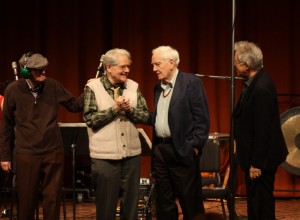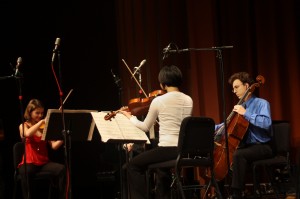
Although Ann Arbor’s ONCE. MORE. festival, celebrating the 50th anniversary of the ONCE Group composers, does not end until tonight, the events with the surviving founders of the groundbreaking concert series – Roger Reynolds, Robert Ashley, Gordon Mumma and Donald Scavarda – concluded Thursday evening. That night’s ONCE. NOW. concert featured more recent works by these four composers.
Robert Ashley’s Van Cao’s Meditation (1991), for piano, opened the evening. The piece was resonant, repetitive, and reminded me of Satie’s Ogives in spirit. Essentially, Van Cao’s Meditation milled about one confined group of a few notes which covered all registers of the piano and, at the end of each phrase, settled on an octave which was not part of this more prevalent pitch collection. The piece was over half and hour long, so the music’s motion through time was made interesting by altering the dynamics and lengths of phrases.
More importantly, the performance is meant to be intensely physical – as Ashley said before the piece, the player must have the music, “in their body” – and Pianist Ming-Hsiu Yen succeeded in delivering the work in a beautifully corporeal way. Most profound was the flowing of Ming-Hsu’s arms as she ascended and descended the arpeggiated figure at the heart of the piece. Perhaps because the work’s musical landscape is so static, Ashley placed a higher premium on the physical aspects of Thursday’s performance, even going so far as to request Ming-Hsiu wear a sleeveless top in the concert. These inferences notwithstanding, Ashley’s piece, despite its epic length, was a wild success on Thursday and many people I talked to after the concert said their reaction to Van Cao’s Meditation was profoundly visceral.
Gordon Mumma’s Than Particle (1985) was next on the program and featured one of the most well-received performances of this week’s concerts. University of Michigan Associate Professor of Percussion Joseph Gramley dazzled in this duet between a percussion soloist and electronic sounds. The synthesized part is from a long-obsolete Yamaha computer program, but Mumma insists on using this version of the electronics because, “some of the synthesized percussion sounds are absurd”. Mr. Gramley’s performance was commandingly athletic and lyrical, particularly when he abandoned his mallets for his fingertips. The percussion part at these moments was unbelievably delicate and juxtaposed humorously with the clumsy timbre of the electronics. Deservedly, Mr. Gramley earned the evening’s first curtain call.
Than Particle closed the first half of music on Thursday, and the final set of pieces began with Donald Scavarda’s CineMATRIX (2002). Like Tuesday night’s FilmSCORE, CineMATRIX calls on its performers – this time four members of the Ann Arbor Improvisation Collective – to extemporaneously interpret a film as their musical score. “People have asked how I made the film,” explained Scavarda before the piece, “there is no easy answer to that question except to say that it was complicated.” Accordingly, CineMATRIX’s images were more advanced than FilmSCORE’s moving dots. Here, the ensemble, under the direction of University of Michigan Assistant Professor of Jazz and Contemporary Improvisation Andrew Bishop, had to respond to a variegated visual field of constantly changing colored boxes. At points, the whole frame would take on a color, and at others different regions would break away from each other in both brightness and pigmentation.
CineMATRIX’s premise related heavily to Scavarda’s other piece of Thursday’s program, Sounds for Seven (2010). Here, a larger ensemble was given a still image for a score, but its content resembled CineMATRIX insofar as the graphic was also composed of many differently colored boxes. In each work, the musicians produced truly elegant realizations of their stimuli. I was particularly impressed with Sounds for Seven because of how well the group drew a unified sound from its diverse instrumentation of clarinet, oboe, bass clarinet, alto saxophone, keyboard synthesizer and electric guitar. CineMATRIX was also very well done, my only complaint is that it ended too soon; I wanted to here more of where it was going.
Between CineMATRIX and Sounds for Seven came Gordon Mumma’s Gambreled Tapestry (2007), for piano and internal electro-acoustics, which he played himself. Mumma explained in his comments before Than Particle that the electronic part here was only meant to enhance the natural resonance of the piano, which is exactly how it behaved in performance. Truly, Gambreled Tapestry’s electronics were some of the most tasteful I have ever heard in an electro-acoustic work. Just barely perceptible for most of the piece, the synthesized element added surreality to the piece’s sound world and melded perfectly with the pointillistic piano part. Gambreled Tapestry was a stunningly intimate and beautiful presentation of modest musical materials made exceptional by the subtle backing of Mumma’s electronics.

Similar in its well-crafted blend of electronics and acoustic performers was the evening’s final work, Roger Reynold’s Ariadne’s Thread (1994) for string quartet, and computer synthesized and spatialized sound. I had heard this piece a couple times before the performance, so my perspective was more experience than the rest of the audience. This is important to specify because, like most of Reynolds’ music, Ariadne’s Thread is incredibly dense. Based on an ancient Greek myth, Ariadne’s Thread is not explicitly programmatic, though Reynold’s use of electronics was intended to represent the, “extra-human” forces at play in the original story of Theseus and the Minotaur.
The electronics, at their apex, overpowered the quartet, but this was by design. The players were amplified but, as Reynolds explained in rehearsal, “the idea is that the tape is extremely strong, but we can hear [the quartet] through it.” Cleverly, the amplification remains activated for most of the piece – the electronics enter about one third into the work – and it is only removed right before the end, which is quiet and should sound like the music’s potential energy has been exhausted. Reynold’s thoughtfulness – epitomized by this consideration of how the amplification fits into the work’s dramaturgy – is clearly palpable in Ariadne’s Thread, even if the listener finds the musical language initially impenetrable. As thorny as the surface of Reynolds’ music may seem upon first listen, he engenders important gestures with strong identities such that events make sense when they recur, even if only in our subconscious. The perception of all these musical elements was made possible only by the fantastic performance of the players, all University of Michigan students. Their stage presence was undeniably ferocious, and this strong group-confidence was critical to their transmission of the messages in Ariadne’s Thread which existed beyond the notes.
It is impossible for me to appropriately summarize the gravity of the entire ONCE. MORE. festival without making this post irresponsibly long. If you are in the Ann Arbor area, there is still ONCE related music to be had: tonight is a concert commemorating the 25th anniversary of the Performing Arts Technology department at the University of Michigan School of Music. Go here for more information (tonight’s concert is at the bottom of the page). Otherwise, please check back to Sequenza21 over the rest of the weekend for my final retrospective piece on the holistic impression of coming into contact with these brilliant and fiercely intelligent composers.

The original festival recordings were documented and released by New World Records and a few years back — 6 hours of music plus a 140 page booklet with a lengthy scholarly essay by musicologist and biographer Leta Miller. The last of the five CDs features the first of the 35 festival works to be by a woman composer — Pauline Oliveros’s “Applebox Double” (1966).
New World Records generously makes its extensive liner notes (a 222K PDF file) about the original festival available without cost here:
http://www.newworldrecords.org/album.cgi?rm=view&album_id=80567
I know that the University Musical Society (UMS) hired professional audio and video recording crews (the latter came in from MODE records in New York!), but I don’t know when anything wil be released. You can contact UMS at http://www.ums.org
Great post. Will any of this be recorded?